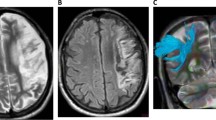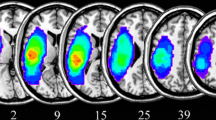Abstract
Previous regional-based diffusion tensor imaging (DTI) studies focused on impairment of the arcuate fasciculus in aphasia; little is known about the extent to which aphasia severity is affected by damage to both ventral and dorsal language white matter (WM) pathways. To understand whether disconnection of these pathways contributes to clinical symptoms, we assessed the relationship between the alterations of WM integrity and clinical characteristics in acute aphasia after stroke. Eighteen patients with acute aphasia and age-, gender-, and education-matched healthy controls underwent language assessment and DTI scanning. The whole brain unbiased tract-based spatial statistics method was employed to quantitate WM integrity (fractional anisotropy) for both groups. Linear correlation analyses were performed to evaluate the relationship between WM integrity and clinical features. The aphasic patients showed decreased WM integrity in the left inferior fronto-occipital fasciculus/inferior longitudinal fasciculus (IFOF/ILF) and the left uncinate fasciculus, which represents components of ventral language pathway, and the left superior longitudinal fasciculus (SLF), which relates to dorsal language pathway. In addition, WM integrity of the left IFOF and SLF showed a positive correlation with aphasia quotient, performance quotient, and cortical quotient, respectively. These findings suggested that impaired WM integrity in both language pathways not only contributed to language performance, but also to general cognitive status. We suggest that aphasia involves a breakdown of multiple connections of dorsal and ventral streams that directly contributes to language deficits. Damage to these dual-streams may serve as a neuromarker for aphasias after stroke.



Similar content being viewed by others
Abbreviations
- ABC:
-
Aphasia battery of Chinese
- AF:
-
Arcuate fasciculus
- AQ:
-
Aphasia quotient
- CQ:
-
Cortical quotient
- DTI:
-
Diffusion tensor imaging
- FA:
-
Fractional anisotropy
- IFOF:
-
Inferior fronto-occipital fasciculus
- ILF:
-
Inferior longitudinal fasciculus
- PQ:
-
Performance quotient
- ROI:
-
Region of interest
- SLF:
-
Superior longitudinal fasciculus
- TBSS:
-
Tract-based spatial statistics
- UF:
-
Uncinate fasciculus
- WM:
-
White matter
References
Allendorfer JB, Storrs JM, Szaflarski JP (2012) Changes in white matter integrity follow excitatory rTMS treatment of post-stroke aphasia. Restor Neurol Neurosci 30:103–113
Ardila A (2010) A proposed reinterpretation and reclassification of aphasic syndromes. Aphasiology 24:363–394
Basser PJ, Mattiello J, LeBihan D (1994) MR diffusion tensor spectroscopy and imaging. Biophys J 66:259–267
Bernal B, Ardila A (2009) The role of the arcuate fasciculus in conduction aphasia. Brain 132:2309–2316
Bonilha L, Nesland T, Rorden C, Fillmore P, Ratnayake RP, Fridriksson J (2014a) Mapping remote subcortical ramifications of injury after ischemic strokes. Behav Neurol 2014:215380
Bonilha L, Rorden C, Fridriksson J (2014b) Assessing the clinical effect of residual cortical disconnection after ischemic strokes. Stroke 45:988–993
Bonilha L, Gleichgerrcht E, Nesland T, Rorden CFridriksson J (2015) Success of anomia treatment in aphasia is associated with preserved architecture of global and left temporal lobe structural networks. Neurorehabil Neural Repair 30:266–279
Breier JI, Hasan KM, Zhang W, Men D, Papanicolaou AC (2008) Language dysfunction after stroke and damage to white matter tracts evaluated using diffusion tensor imaging. AJNR Am J Neuroradiol 29:483–487
Brett M, Leff AP, Rorden C, Ashburner J (2001) Spatial normalization of brain images with focal lesions using cost function masking. Neuroimage 14:486–500
Catani M, Mesulam MM, Jakobsen E, Malik F, Martersteck A, Wieneke C et al (2013) A novel frontal pathway underlies verbal fluency in primary progressive aphasia. Brain 136:2619–2628
Crinion JT, Leff AP (2015) Using functional imaging to understand therapeutic effects in poststroke aphasia. Curr Opin Neurol 28:330–337
Damasio AR (1992) Aphasia. N Engl J Med 326:531–539
Dick AS, Tremblay P (2012) Beyond the arcuate fasciculus: consensus and controversy in the connectional anatomy of language. Brain 135:3529–3550
Forkel SJ, Thiebaut de Schotten M, Dell’Acqua F, Kalra L, Murphy DG, Williams SC et al (2014) Anatomical predictors of aphasia recovery: a tractography study of bilateral perisylvian language networks. Brain 137:2027–2039
Frey S, Campbell JS, Pike GB, Petrides M (2008) Dissociating the human language pathways with high angular resolution diffusion fiber tractography. J Neurosci 28:11435–11444
Fridriksson J, Guo D, Fillmore P, Holland A, Rorden C (2013) Damage to the anterior arcuate fasciculus predicts non-fluent speech production in aphasia. Brain 136:3451–3460
Galantucci S, Tartaglia MC, Wilson SM, Henry ML, Filippi M, Agosta F et al (2011) White matter damage in primary progressive aphasias: a diffusion tensor tractography study. Brain 134:3011–3029
Gao SR, Chu YF, Shi SQ, Peng Y, Dai SD, Wang MH (1992) A standardization research of the aphasia battery of Chinese. Chin Ment Health J (Chinese) 6:125–128
Geva S, Baron JC, Jones PS, Price CJ, Warburton EA (2012) A comparison of VLSM and VBM in a cohort of patients with post-stroke aphasia. Neuroimage Clin 1:37–47
Geva S, Correia MM, Warburton EA (2015) Contributions of bilateral white matter to chronic aphasia symptoms as assessed by diffusion tensor MRI. Brain Lang 150:117–128
Hickok G, Poeppel D (2004) Dorsal and ventral streams: a framework for understanding aspects of the functional anatomy of language. Cognition 92:67–99
Hickok G, Poeppel D (2007) The cortical organization of speech processing. Nat Rev Neurosci 8:393–402
Hua K, Zhang J, Wakana S, Jiang H, Li X, Reich DS et al (2008) Tract probability maps in stereotaxic spaces: analyses of white matter anatomy and tract-specific quantification. Neuroimage 39:336–347
Jang SH (2013) Diffusion tensor imaging studies on arcuate fasciculus in stroke patients: a review. Front Hum Neurosci 7:749
Ji GJ, Zhang Z, Xu Q, Wei W, Wang J, Wang Z et al (2015) Connectome reorganization associated with surgical outcome in temporal lobe epilepsy. Medicine (Baltimore) 94:e1737
Kim SH, Lee DG, You H, Son SM, Cho YW, Chang MC et al (2011) The clinical application of the arcuate fasciculus for stroke patients with aphasia: a diffusion tensor tractography study. Neurorehabilitation 29:305–310
Kochunov P, Thompson PM, Lancaster JL, Bartzokis G, Smith S, Coyle T et al (2007) Relationship between white matter fractional anisotropy and other indices of cerebral health in normal aging: tract-based spatial statistics study of aging. Neuroimage 35:478–487
Krestel H, Annoni JM, Jagella C (2013) White matter in aphasia: a historical review of the Dejerines’ studies. Brain Lang 127:526–532
Kummerer D, Hartwigsen G, Kellmeyer P, Glauche V, Mader I, Kloppel S et al (2013) Damage to ventral and dorsal language pathways in acute aphasia. Brain 136:619–629
Kwon HG, Jang SH (2011) Excellent recovery of aphasia in a patient with complete injury of the arcuate fasciculus in the dominant hemisphere. Neurorehabilitation 29:401–404
Liao W, Ji GJ, Xu Q, Wei W, Wang J, Wang Z et al (2016) Functional connectome before and following temporal lobectomy in mesial temporal lobe epilepsy. Sci Rep 6:23153
Liu L, Luo XG, Dy CL, Ren Y, Feng Y, Yu HM et al (2015) Characteristics of language impairment in Parkinson’s disease and its influencing factors. Transl Neurodegener 4:2
Lu J, Wu J, Yao C, Zhuang D, Qiu T, Hu X et al (2013) Awake language mapping and 3-Tesla intraoperative MRI-guided volumetric resection for gliomas in language areas. J Clin Neurosci 20:1280–1287
Maldonado IL, Moritz-Gasser S, de Champfleur NM, Bertram L, Moulinie G, Duffau H (2011) Surgery for gliomas involving the left inferior parietal lobule: new insights into the functional anatomy provided by stimulation mapping in awake patients. J Neurosurg 115:770–779
Patterson K, Nestor PJ, Rogers TT (2007) Where do you know what you know? The representation of semantic knowledge in the human brain. Nat Rev Neurosci 8:976–987
Price CJ (2012) A review and synthesis of the first 20 years of PET and fMRI studies of heard speech, spoken language and reading. Neuroimage 62:816–847
Rosso C, Vargas P, Valabregue R, Arbizu C, Henry-Amar F, Leger A et al (2015) Aphasia severity in chronic stroke patients: a combined disconnection in the dorsal and ventral language pathways. Neurorehabil Neural Repair 29:287–295
Saur D, Kreher BW, Schnell S, Kummerer D, Kellmeyer P, Vry MS et al (2008) Ventral and dorsal pathways for language. Proc Natl Acad Sci USA 105:18035–18040
Schlaug G, Marchina S, Norton A (2009) Evidence for plasticity in white-matter tracts of patients with chronic Broca’s aphasia undergoing intense intonation-based speech therapy. Ann N Y Acad Sci 1169:385–394
Selnes OA, Van Zijl PC, Barker PB, Hillis AE, Mori S (2002) MR diffusion tensor imaging documented arcuate fasciculus lesion in a patient with normal repetition performance. Aphasiology 16:897–902
Smith SM, Jenkinson M, Johansen-Berg H, Rueckert D, Nichols TE, Mackay CE et al (2006) Tract-based spatial statistics: voxelwise analysis of multi-subject diffusion data. Neuroimage 31:1487–1505
Tak HJ, Jang SH (2014) Relation between aphasia and arcuate fasciculus in chronic stroke patients. BMC Neurol 14:46
Thomas SA, Lincoln NB (2008) Predictors of emotional distress after stroke. Stroke 39:1240–1245
Tsapkini K, Frangakis CE, Hillis AE (2011) The function of the left anterior temporal pole: evidence from acute stroke and infarct volume. Brain 134:3094–3105
Turken AU, Dronkers NF (2011) The neural architecture of the language comprehension network: converging evidence from lesion and connectivity analyses. Front Syst Neurosci 5:1
van Hees S, McMahon K, Angwin A, de Zubicaray G, Read S, Copland DA (2014a) Changes in white matter connectivity following therapy for anomia post stroke. Neurorehabil Neural Repair 28:325–334
van Hees S, McMahon K, Angwin A, de Zubicaray G, Read S, Copland DA (2014b) A functional MRI study of the relationship between naming treatment outcomes and resting state functional connectivity in post-stroke aphasia. Hum Brain Mapp 35:3919–3931
Warren JE, Wise RJ, Warren JD (2005) Sounds do-able: auditory-motor transformations and the posterior temporal plane. Trends Neurosci 28:636–643
Warren JE, Crinion JT, Lambon Ralph MA, Wise RJ (2009) Anterior temporal lobe connectivity correlates with functional outcome after aphasic stroke. Brain 132:3428–3442
Yang M, Li J, Li Y, Li R, Pang Y, Yao D et al (2016a) Altered intrinsic regional activity and interregional functional connectivity in post-stroke aphasia. Sci Rep 6:24803
Yang M, Li J, Yao D, Chen H (2016b) Disrupted intrinsic local synchronization in poststroke aphasia. Medicine (Baltimore) 95:e3101
Yu ZZ, Jiang SJ, Bi S, Li J, Lei D, Sun LL (2013) Relationship between linguistic functions and cognitive functions in a clinical study of Chinese patients with post-stroke aphasia. Chin Med J (Engl) 126:1252–1256
Zhu D, Chang J, Freeman S, Tan Z, Xiao J, Gao Y et al (2014) Changes of functional connectivity in the left frontoparietal network following aphasic stroke. Front Behav Neurosci 8:167
Acknowledgments
We thank to the radiologist Ying Liu in the Hospital of Fuzhou for manually traced the outline of the lesion. This work was supported by the 973 project (2012CB517901), 863 project (2015AA020505), Natural Science Foundation of China (61533006, and 81471653), China Postdoctoral Science Foundation (No. 2013M532229), and Fundamental Research Funds for the Central Universities (ZYGX2013Z004).
Author Contributions
DY, WL, and HC designed the study. MY, YL, and JL contributed to data collection. MY, YL, JL, WL and HC contributed to data analysis, data interpretation, and manuscript preparation. All authors read and approved the final manuscript.
Author information
Authors and Affiliations
Corresponding authors
Ethics declarations
Conflict of interest
The authors declare that they have no conflict of interest.
Rights and permissions
About this article
Cite this article
Yang, M., Li, Y., Li, J. et al. Beyond the Arcuate Fasciculus: Damage to Ventral and Dorsal Language Pathways in Aphasia. Brain Topogr 30, 249–256 (2017). https://doi.org/10.1007/s10548-016-0503-5
Received:
Accepted:
Published:
Issue Date:
DOI: https://doi.org/10.1007/s10548-016-0503-5




